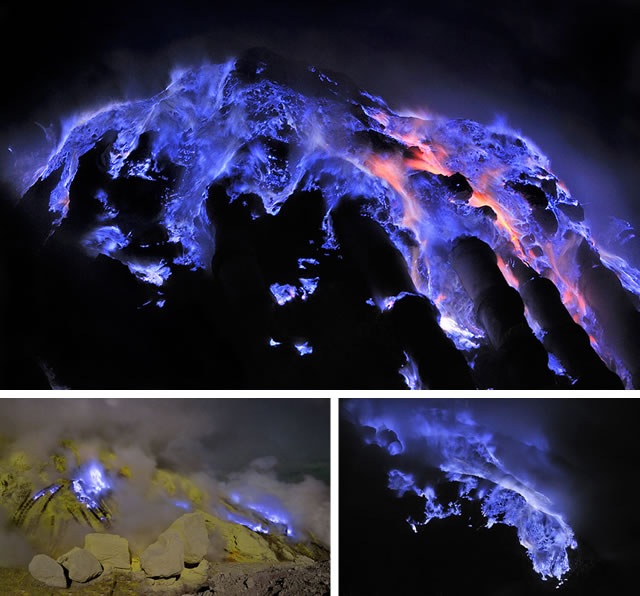
Credit: Olivier Grunewald
Fuori da questo mondo: mentre queste immagini possono sembrare provenire da un altro pianeta, sono in realtà prodotte da zolfo qui sulla Terra.
A prima vista si potrebbe pensare che la luce ultraterrena ripresa in queste immagini possa venire da una nebulosa o da un altro pianeta dello spazio profondo. In realtà si tratta di zolfo incandescente che si riversa da un lato del vulcano Kawah Ijen, sul pianeta Terra, che fa parte del complesso vulcano Ijen ad est di Java, in Indonesia. I minatori hanno costruito dei tubi di ceramica dagli sfiati nel fianco della montagna per conglobarli in punti di raccolta all’interno di un grande cratere dove la sostanza chimica fusa viene lasciata raffreddare prima di essere rotta e portata via. Lo zolfo appare rosso brillante durante il giorno, ma come il sole tramonta le fiamme blu, che possono arrivare fino a cinque metri di altezza, iniziano a diventare visibili. I minatori si preoccupano poi anche di spostare i pesantissimi blocchi solidi di zolfo su un pendio molto ripido, al fine di venderli, utilizzando nient’altro che un cesto e le loro mani nude. Il fotografo Olivier Grunewald, che ha catturato alcuni di questi scatti sorprendenti, ha dovuto indossare una maschera antigas durante la sua spedizione nel cratere, perdendo due lenti e una macchina fotografica durante il tentativo di catturare queste straordinarie immagini.
Out of this world: While these pictures may appear to be from another planet, they are in fact produced by burning sulphur here on Earth.
At first glance you might think the otherworldly light in these pictures comes from a nebula or another planet deep in outer space. In fact it is made by burning sulphur which pours from the side of the Kawah Ijen volcano on planet Earth, which is part of the Ijen volcano complex in East Java, Indonesia. Miners have run ceramic pipes from vents in the side of the mountain to collection points inside a large crater where the molten chemical is left to cool before being broken up and carried away. The sulphur appears bright red during the day, but as the sun sets the blue flames – which can reach up to five foot in height – start to become visible. They must also move solid blocks of sulphur weighing up to 220lb up a very steep slope in order to sell them, using nothing more than a basket and their bare hands. Photographer Olivier Grunewald, who captured some of these amazing shots, had to wear a gas mask during his expedition into the crater, and lost two lenses and a camera while trying to capture the mysterious pictures.
Source/Continue reading → www.dailymail.co.uk





















